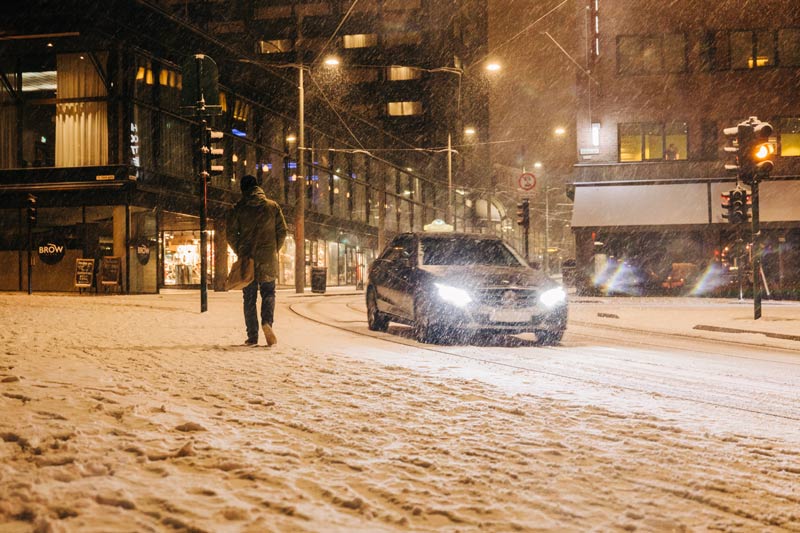When you drive for work, it’s important to take extra care during the winter. Especially in cold, snowy climates like Michigan, winter weather can hit hard, making it difficult to drive safely. Before you head out on any drive this winter, be sure you’ve reviewed and are familiar with your company’s driving safety guidelines. The tips below can also help refresh your memory on winter driving safety best practices before you hit the road.
Prepare: What to Do Before Your Winter Drive
Before you take the company vehicle out on the road, it’s important to make sure you are prepared for the drive. Follow these safety tips to ensure your company car is road-ready and you have the supplies you need to handle snowy weather.
Inspect the Vehicle
Before you go, take time to inspect your company vehicle. Make sure all features and systems are functioning properly.
- Test the battery. Cold temperatures can affect battery power.
- Check fluid levels including oil, wiper fluid, and antifreeze.
- Test your lights, including:
- Headlights
- Brake lights
- Turn signals
- Hazard lights
- Interior lights
- Ensure winter wiper fluid rated for -30°F has been added.
- Replace wiper blades if needed.
- Make sure brakes are functioning properly.
- Ensure tires are properly inflated. Cold temperatures can cause tire pressure to drop.
- Check that the heater and windshield defroster work.
Keep Gas Tank Full
In the winter, it’s a good idea to keep your gas tank at least half full. This helps to avoid a frozen gas line and ensures you have enough fuel to keep warm in the event that you became stuck.
Stock Up the Car Before You Head Out
Make sure you are prepared for anything. In the event that you are in an accident or become stuck, you need to have essentials handy that can keep you safe. Before you head out on the road for work this winter, ensure your car is well-stocked with:
- Snow scraper
- Snow brush
- Extra wiper fluid
- Sand or kitty litter
- Jumper cables
- Flashlight
- Blankets
- Gloves
- Boots
Dress for the Weather
Even if your company provides snow scrapers, blankets, and other essentials for safe winter driving, it’s still important that you’re dressing for the weather conditions, just in case you become stuck or your vehicle breaks down. Make sure you’re wearing warm clothes, a winter coat, and proper footwear.
Warm up the Car
It’s important to give your vehicle plenty of time to warm up before you start driving in the winter. Before you leave, pull the car out of any enclosed space, and give it 5-10 minutes to warm up and defrost. This will ensure you have proper visibility when you’re ready to hit the road. If there is still ice or snow on the vehicle after it has warmed up, be sure to remove it with your snow scraper or brush before you start driving.
Plan Your Route
It’s always important to know your route before you hit the road, but take extra time to plan and memorize your drive before you start driving in the winter. Snowy roads are dangerous, and you don’t want to have to take your eye off the road at all. While your car is warming up, take some time to go over your route, so you can set any directions to the side when you start driving.
Prevent an Accident: Winter Driving Tips to Keep You Safe On the Road
Snow and ice make roads hazardous. To help stay safe, be sure to follow these tips for winter driving:
- Drive slowly. Adjust your speed to account for poor road conditions. Accelerate and decelerate slowly to maintain traction on snowy or icy roads.
- Increase follow distance. Don’t follow other cars too closely. Increase your following distance to between 8-10 seconds when you’re driving in the winter.
- Do not use cruise control. When driving on wintery roads covered in ice and snow, cruise control can be dangerous.
- Know your brakes. Make sure you know whether you have antilock brakes or not, so you can brake properly.
- Avoid stopping when possible. Coming to a hard stop can cause you to skid or slide on icy roads. When possible, carefully decelerate to a slow roll, rather than stopping completely.
- Don’t stop when going uphill. Getting a heavy car moving on a steep, icy hill is difficult and dangerous. Whenever possible, get some momentum going on a flat roadway before you carefully cruise up the hill.
- Don’t crowd snow plows. Snow plow drivers have limited visibility. Don’t drive too closely behind or next to a snowplow and use caution when passing.
- Take extra steps to avoid fatigue. Shorter days and weaker sunlight can cause you to feel more tired. When driving for work, be sure to take regular breaks to prevent fatigue.
What to Do if You Get Stuck In Your Company Vehicle This Winter
If you are stopped or stalled on the road in winter weather, follow your company’s safety guidelines to call the appropriate parties for help. While you wait for help to arrive, follow these safety tips:
- Stay with your car. Don’t leave your car to walk for help and don’t overexert yourself.
- Turn on your hazards. Make yourself visible to other drivers. Turn on your hazard lights and put bright markers on your vehicle’s antenna or windows if you have them.
- Don’t run your car for long periods of time. To avoid carbon monoxide poisoning, clear the exhaust pipe of any snow, and only run your vehicle long enough to stay warm. This will also help to conserve fuel.
These winter driving tips can help keep you safe, whether it’s a work related trip or personal travel. Winter driving requires a little extra care and attention no matter where you’re going, so be sure to prepare your car, take a little extra time getting ready, and drive safely once you hit the road.
For more information about employee driver safety, consider eSafety’s course on Driver Safety. To learn more about our courses, contact our team online or request a free quote today.

